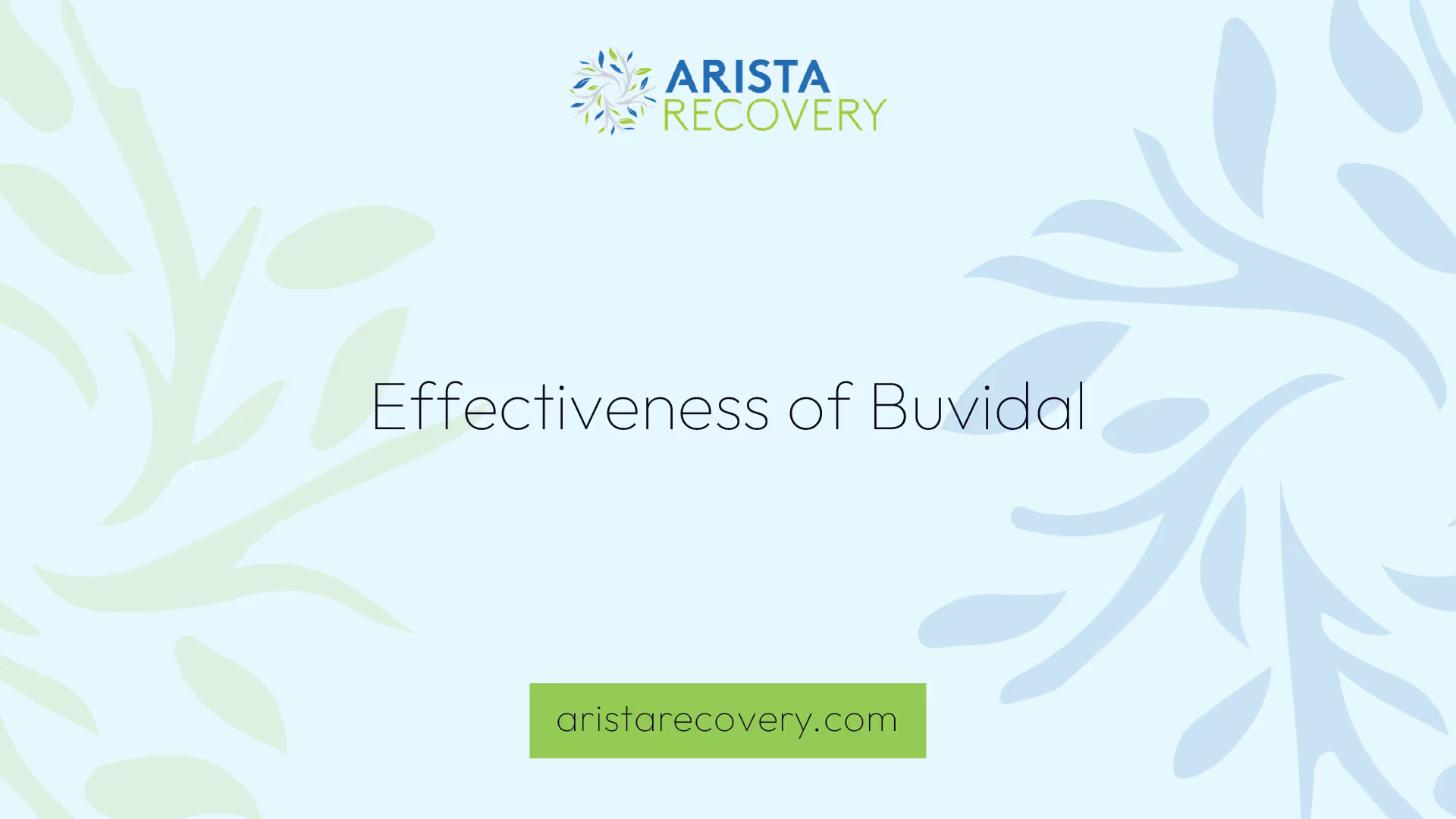What is Buvidal Used for in Addiction Disorder?

Understanding Buvidal for Addiction

Introduction to Buvidal
Buvidal is a medication specifically designed to treat individuals dependent on opioid (narcotic) drugs, such as heroin or morphine. It is intended for adults and adolescents aged over 16 years who are also receiving comprehensive medical, social, and psychological support. Buvidal contains buprenorphine, which is the active substance responsible for its therapeutic effects.
This medication is classified as a ‘hybrid medicine’ and is administered via injection under the skin, either on a weekly or monthly basis. Buvidal can only be obtained with a prescription and must be administered by a healthcare professional.
Mechanism of Action
Buvidal functions by utilizing the properties of buprenorphine, which acts as a partial agonist at the opioid receptors in the brain. This means that while it activates the opioid receptors, it does so to a lesser extent compared to full agonists like heroin or morphine. As a result, Buvidal alleviates withdrawal symptoms and cravings without producing the same level of euphoria associated with stronger opioids [2].
The initial dose of Buvidal for individuals using heroin or short-acting opioids should be given only after a minimum of 6 hours following the last opioid use. For those transitioning from methadone, the methadone dosage must be reduced to no more than 30 mg per day, and Buvidal should not be administered until at least 24 hours after the last methadone dose to prevent withdrawal symptoms.
The recommended starting dose of Buvidal is typically 16 mg, with the possibility of adding one or two additional 8 mg doses at least one day apart to achieve a target dose of 24 mg or 32 mg during the first treatment week. The dose for the second treatment week is based on the total dose administered during the initiation week [3].
Understanding how Buvidal works and its intended use helps individuals grasp the importance of this treatment within the broader context of addiction recovery. For those seeking effective solutions, Buvidal represents a significant step towards managing opioid dependence.

Usage and Administration
Buvidal is an essential treatment for individuals struggling with opioid dependence. Understanding the correct usage and administration is crucial for effective recovery.
Treatment Protocol
Buvidal is primarily used for treating dependence on opioid drugs like heroin or morphine. It is recommended for adults and adolescents aged over 16 years, provided they also receive additional medical, social, and psychological support [1].
The treatment protocol begins with the first dose being administered when the patient exhibits clear signs of withdrawal. For those dependent on short-acting opioids, the first Buvidal dose should occur at least six hours after the last opioid use. In cases of long-acting opioids, the dose of methadone must be reduced prior to starting on Buvidal [1].
Dosing Guidelines
The dosing guidelines for Buvidal are structured to ensure effective management of opioid dependence.
Patients currently on sublingual buprenorphine can switch directly to either weekly or monthly Buvidal, starting the day after their last dose of sublingual treatment, following the provided dosing recommendations [3].
For more information on buprenorphine treatment, refer to how does opioid agonist therapy work? or learn about the leading treatment for opioid use disorder?.

Effectiveness of Buvidal
Buvidal has emerged as a significant option for the treatment of opioid dependence. Its effectiveness is evaluated through various measures, including the reduction in opioid intake and comparative analysis with other treatments.
Reduction in Opioid Intake
Buvidal is specifically designed to address dependence on opioid drugs such as heroin and morphine. According to a study involving 428 patients with opioid dependence, Buvidal demonstrated a substantial impact on reducing opioid intake. Over a 25-week treatment period, 35% of patients receiving Buvidal tested negative for opioids in urine tests, compared to 28% of patients who were given comparator tablets. This data indicates that Buvidal can significantly help patients in decreasing their reliance on opioid substances.
Comparative Analysis
In terms of effectiveness, Buvidal has been compared to buprenorphine tablets, another established treatment for opioid dependence. The European Medicines Agency concluded that Buvidal was at least as effective as buprenorphine tablets, providing an additional therapeutic option for managing opioid addiction [1].
Buprenorphine maintenance therapy has several benefits, including a reduced risk of health complications associated with injecting drugs, such as HIV and hepatitis B and C. It also poses a lower risk of overdose compared to heroin. Buvidal, being a long-acting injectable form of buprenorphine, offers similar advantages, requiring administration only weekly or monthly. This can enhance adherence to treatment and improve overall recovery outcomes.
For further exploration of Buvidal’s role in treating opioid dependence, refer to our articles on how does opioid agonist therapy work? and leading treatment for opioid use disorder?.
Benefits of Buvidal Treatment
Buvidal offers several advantages for individuals seeking recovery from addiction disorders. These benefits encompass both health-related and economic aspects.
Health Advantages
Buvidal, a form of long-acting injectable buprenorphine, serves as a replacement therapy for individuals dependent on heroin and methadone. Its administration helps prevent physical withdrawal symptoms and stabilizes the lives of those affected by opioid dependence. Notable health benefits of Buvidal treatment include:
- Reduced Health Risks: Buprenorphine maintenance therapy is advantageous compared to heroin use as it significantly lowers health issues related to injecting drugs. These issues include HIV, hepatitis B and C, skin infections, and vein complications.
- Lower Overdose Risk: Buvidal is less likely to result in overdose compared to full opioid agonists like morphine or fentanyl, making it a safer alternative for those in recovery.
- Longer Dosing Intervals: With Buvidal, individuals require injections only weekly or monthly, providing a more manageable treatment schedule compared to daily dosing regimes.
For more information on this treatment modality, visit our article on how does opioid agonist therapy work?.
Cost-Effectiveness
Buvidal is also regarded as a cost-effective option for managing opioid dependence. Compared to the costs associated with illicit drug use, Buvidal offers significant economic benefits:
- Reduced Overall Costs: The financial burden of purchasing heroin or other opioids can be substantial. Buvidal presents a more economical alternative, reducing expenses related to drug acquisition.
- Lower Healthcare Costs: By minimizing health complications associated with opioid use, Buvidal can help decrease healthcare expenditures over time. This includes reduced hospital visits and treatments for infections or overdose incidents.
For further insights into treatment options for opioid use disorder, check our article on leading treatment for opioid use disorder?.
Buvidal treatment, when integrated into a comprehensive recovery plan, not only supports physical health but also proves to be a financially sound choice for individuals navigating the challenges of addiction.
Buvidal vs. Other Treatments
In the landscape of addiction treatment, Buvidal stands out as a promising option. This section will compare Buvidal to Sublocade and other long-acting injectable buprenorphine therapies, highlighting their similarities and differences.
Comparison with Sublocade
Buvidal and Sublocade are both forms of long-acting injectable buprenorphine used to treat opioid dependence, including heroin and methadone addiction. They are administered through subcutaneous injections, either weekly or monthly, allowing for a steady release of buprenorphine into the bloodstream [4].
Buvidal provides flexibility in dosing, allowing for adjustment based on individual patient needs and clinical judgment. This can be particularly beneficial for patients who may require more frequent monitoring or adjustments in their treatment plan. In contrast, Sublocade offers a more standardized monthly dosage, which simplifies administration but may lack the same level of personalized care.
Both options provide significant advantages over the use of heroin, such as reduced health risks associated with intravenous drug use, including the transmission of HIV and hepatitis B and C [4]. Additionally, buprenorphine is less likely to lead to overdose compared to full opioid agonists like heroin.
Long-Acting Injectable Buprenorphine
In a broader context, Buvidal and Sublocade represent a category of long-acting injectable buprenorphine treatments. These therapies leverage buprenorphine's unique pharmacological properties, which include partial agonist action at mu-opioid receptors, slow-dissociation kinetics, and ceiling effects on respiratory depression. This makes them safer alternatives to full agonists like morphine and fentanyl, offering reduced potential for overdose and milder withdrawal symptoms [5].
Overall, both Buvidal and Sublocade, along with other long-acting injectable buprenorphine treatments, represent significant advancements in the management of opioid use disorder. They provide patients with effective alternatives to traditional therapies, aligning with the evolving landscape of addiction treatment. For more information on buprenorphine's role in opioid agonist therapy, check out our article on how does opioid agonist therapy work?.
Regulatory Changes and Future Prospects
Understanding the regulatory environment surrounding Buvidal is crucial for both healthcare providers and individuals seeking treatment for addiction disorders. Recent legislative changes aim to improve access to treatment options, including Buvidal.
Data Waiver Elimination
Before January 2023, clinicians needed to obtain a DATA waiver, commonly referred to as an X-waiver, to prescribe buprenorphine for treating opioid use disorders (OUDs). Following the enactment of the Consolidated Appropriations Act of 2023, this requirement was eliminated. Clinicians with Schedule III authority on their DEA registration can now prescribe buprenorphine without the necessity of a DATA waiver. This significant change aims to increase access to buprenorphine treatment, addressing the ongoing opioid epidemic in the United States [5].
The MAT Act Provision
The Mainstreaming Addiction Treatment (MAT) Act provision further updates federal guidelines to expand the availability of evidence-based treatment for OUD. This provision empowers all healthcare providers with a standard controlled substance license to prescribe buprenorphine, aligning it with the prescription of other essential medications. As of December 2022, the MAT Act has effectively eliminated the DATA-waiver (X-waiver) program. Practitioners registered with the DEA and possessing Schedule III authority can now prescribe buprenorphine for OUD within their practice [5].
These regulatory changes are expected to have a positive impact on the treatment landscape for individuals with addiction disorders, making it easier for them to access necessary medications. For more information on treatment options, including how does opioid agonist therapy work? and leading treatment for opioid use disorder?, readers can explore further resources.
References
[1]: https://www.ema.europa.eu/en/medicines/human/EPAR/buvidal
[2]: /how-does-opioid-agonist-therapy-work
[3]: https://www.medicines.org.uk/emc/product/11416/smpc
[4]: https://adf.org.au/drug-facts/long-acting-injectable-buprenorphine/
You’re not alone in this.
When mental health challenges and addiction intersect, it can feel isolating. At Arista, we offer compassionate, evidence-based, and trauma-informed care to help you heal, grow, and move forward.
You’re not alone in this.
When mental health challenges and addiction intersect, it can feel isolating. At Arista, we offer compassionate, evidence-based, and trauma-informed care to help you heal, grow, and move forward.
Support that moves with you.
You’ve taken a brave first step. At Arista Recovery, we’re here to help you continue with best-in-class care designed for long-term healing and support.
.webp)






